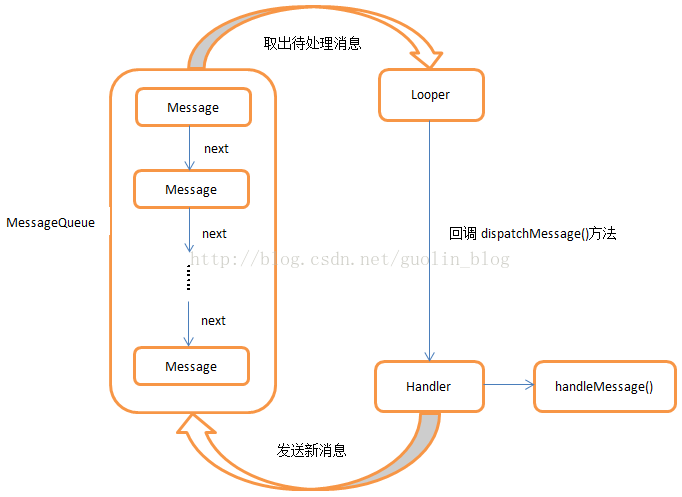今天讲述一下Android的异步消息处理机制,说到异步,我们肯定会想到继承Thread,实现Runnable来处理耗时操作,然后再发消息去处理对应的业务逻辑。相信大家对下面的代码非常熟悉。
public class MainActivity extends Activity {
private static final int MESSAGE = 1;
private static Handler mHandler = new Handler() {
@Override
public void handleMessage(Message msg) {
// TODO Auto-generated method stub
super.handleMessage(msg);
Log.i("Log","text");
}
};
@Override
protected void onCreate(Bundle savedInstanceState) {
// TODO Auto-generated method stub
super.onCreate(savedInstanceState);
CustomThread thread = new CustomThread();
thread.start();
CustomRunnable runnable = new CustomRunnable();
runnable.run();
}
private class CustomThread extends Thread {
@Override
public void run() {
// TODO Auto-generated method stub
super.run();
mHandler.sendEmptyMessage(MESSAGE);
}
};
private class CustomRunnable implements Runnable {
@Override
public void run() {
// TODO Auto-generated method stub
mHandler.sendEmptyMessage(MESSAGE);
}
}
}然而这次的主要内容就是消息处理的原理。
我们首先了解一下以下各元素:
- Message:消息
- MessageQuene:消息队列,可以添加消息,处理消息。
- Looper:消息循环,用于循环取出消息进行处理。
- Handler:发送消息;消息循环从消息队列中取出消息后要对消息进行处理。
我们来看Handler的无参构造方法:
public Handler() {
this(null, false);
} public Handler(Callback callback, boolean async) {
if (FIND_POTENTIAL_LEAKS) {
final Class<? extends Handler> klass = getClass();
if ((klass.isAnonymousClass() || klass.isMemberClass() || klass.isLocalClass()) &&
(klass.getModifiers() & Modifier.STATIC) == 0) {
Log.w(TAG, "The following Handler class should be static or leaks might occur: " +
klass.getCanonicalName());
}
}
mLooper = Looper.myLooper();
if (mLooper == null) {
throw new RuntimeException(
"Can't create handler inside thread that has not called Looper.prepare()");
}
mQueue = mLooper.mQueue;
mCallback = callback;
mAsynchronous = async;
}可以看到,在第10行调用了Looper.myLooper()方法来获取一个Looper对象,如果对象为空,会抛出一个RuntimeException。在获取到当前线程保存的Looper实例后,再获取了这个Looper实例中保存的MessageQueue(消息队列),这样handler、Looper、MessageQueue三者之间就关联上了。我们这接着看Looper.myLooper()是怎么处理的。
public static @Nullable Looper myLooper() {
return sThreadLocal.get();
}在当前线程会get他的消息循环器Looper,在有get(),就肯定有set(),我们可以想到在Looper.prepare()里面set()。那么我们继续往下看源码:
public static void prepare() {
prepare(true);
}
private static void prepare(boolean quitAllowed) {
if (sThreadLocal.get() != null) {
throw new RuntimeException("Only one Looper may be created per thread");
}
sThreadLocal.set(new Looper(quitAllowed));
}这里判断是否已经存在Looper,如果不存在则new一个新的Looper,所以说要先有一个消息循环器Looper,才能创建Handler对象。同时也可以看出每一个线程sThreadLocal只会有一个Looper对象。我们接着看Looper初始化做了些什么?
private Looper(boolean quitAllowed) {
mQueue = new MessageQueue(quitAllowed);
mThread = Thread.currentThread();
}
MessageQueue(boolean quitAllowed) {
mQuitAllowed = quitAllowed;
mPtr = nativeInit();
}在Looper初始化时,新建了一个MessageQueue的对象,赋予mQueue中,MessageQueue的构造方法访问是包可见,所以我们是无法直接使用的。然后还有nativeInit(),nativeInit() 方法创建 NativeMessageQueue 对象,并将这个对象的指针复制给 Android MessageQueue 的 mPtr。关于C++中的nativeXXX方法不做过多分析,需要深究的同学自行查阅资料,我们只要明白mPtr为native层的MessageQueue的指针即可。
此时,回到上面,有同学会说,你这个Looper.prepare(),没有在Handler的构造方法出现啊,是怎么回事。那么我们可以去看一下ActivityThread的main()方法,系统已经帮我们自动调用Looper.prepare()方法了。代码如下:
public static void main(String[] args) {
SamplingProfilerIntegration.start();
CloseGuard.setEnabled(false);
Environment.initForCurrentUser();
EventLogger.setReporter(new EventLoggingReporter());
Process.setArgV0("<pre-initialized>");
Looper.prepareMainLooper();
ActivityThread thread = new ActivityThread();
thread.attach(false);
if (sMainThreadHandler == null) {
sMainThreadHandler = thread.getHandler();
}
AsyncTask.init();
if (false) {
Looper.myLooper().setMessageLogging(new LogPrinter(Log.DEBUG, "ActivityThread"));
}
Looper.loop();
throw new RuntimeException("Main thread loop unexpectedly exited");
} 在第七行调用了Looper.prepareMainLooper()方法。而这个方法又会再去调用Looper.prepare()方法,在最后又会调用Looper.loop()方法,这就是我们平时创建Handler时不写这两个方法的原因。接着我们看prepareMainLooper()代码如下所示:
public static void prepareMainLooper() {
prepare(false);
synchronized (Looper.class) {
if (sMainLooper != null) {
throw new IllegalStateException("The main Looper has already been prepared.");
}
sMainLooper = myLooper();
}
} 这里Main线程(UI线程)初始化消息循环时会调用prepareMainLooper,传进去的是false,消息循环不可以退出,上面说在默认构造方法时可以。接着是调用myLooper(),创建一个消息循环器Looper,因此我们应用程序的主线程中会始终存在一个Looper对象,从而不需要再手动去调用Looper.prepare()方法了。
这样我们大致理顺了Handler的创建过程。那么在创建Handler之后,我们是开线程,线程处理完之后用handler发送消息Message,在文章一开头就演示了一个handler.sendEmptyMessage(arg)。然后我们去翻一下Handler类里面提供了很多发送消息的方法,但是它们最终都是调用sendMessageAtTime(Message msg, long uptimeMillis),这里面发送消息的方法我就不贴了,大家可以去翻翻SDK源码验证下,接着我们直接看sendMessageAtTime()方法源码:
public boolean sendMessageAtTime(Message msg, long uptimeMillis) {
MessageQueue queue = mQueue;
if (queue == null) {
RuntimeException e = new RuntimeException(
this + " sendMessageAtTime() called with no mQueue");
Log.w("Looper", e.getMessage(), e);
return false;
}
return enqueueMessage(queue, msg, uptimeMillis);
}
private boolean enqueueMessage(MessageQueue queue, Message msg, long uptimeMillis) {
msg.target = this;
if (mAsynchronous) {
msg.setAsynchronous(true);
}
return queue.enqueueMessage(msg, uptimeMillis);
}mQueue是一个全局变量,在创建Handler的时候,获取到消息循环器Looper之后,会mQueue = mLooper.mQueue。这里面msg参数就是我们发送的Message对象,而uptimeMillis参数则表示发送消息的时间。我们看到queue.enqueueMessage()方法,这里是MessageQueue类里面的方法,MessageQueue的作用我们上面也简述过,它是一个消息队列,用于将所有收到的消息以队列的形式进行排列,并提供入队和出队的方法。源码如下:
final boolean enqueueMessage(Message msg, long when) {
if (msg.when != 0) {
throw new AndroidRuntimeException(msg + " This message is already in use.");
}
if (msg.target == null && !mQuitAllowed) {
throw new RuntimeException("Main thread not allowed to quit");
}
synchronized (this) {
if (mQuiting) {
RuntimeException e = new RuntimeException(msg.target + " sending message to a Handler on a dead thread");
Log.w("MessageQueue", e.getMessage(), e);
return false;
} else if (msg.target == null) {
mQuiting = true;
}
msg.when = when;
Message p = mMessages;
if (p == null || when == 0 || when < p.when) {
msg.next = p;
mMessages = msg;
this.notify();
} else {
Message prev = null;
while (p != null && p.when <= when) {
prev = p;
p = p.next;
}
msg.next = prev.next;
prev.next = msg;
this.notify();
}
}
return true;
} 从代码看出,MessageQueue并没有使用一个集合把所有的消息都保存起来,它只使用了一个mMessages对象表示当前待处理的消息。然后观察上面的代码我们就可以看出,所谓的入队其实就是将所有的消息按时间来进行排序,这个时间当然就是我们刚才介绍的uptimeMillis参数。具体的操作方法就根据时间的顺序调用msg.next,从而为每一个消息指定它的下一个消息是什么。
现在入队操作我们就已经看明白了,那出队操作是在哪里进行的呢?这个就需要看一看Looper.loop()方法的源码了,如下所示:
public static void loop() {
final Looper me = myLooper();
if (me == null) {
throw new RuntimeException("No Looper; Looper.prepare() wasn't called on this thread.");
}
final MessageQueue queue = me.mQueue;
// Make sure the identity of this thread is that of the local process,
// and keep track of what that identity token actually is.
Binder.clearCallingIdentity();
final long ident = Binder.clearCallingIdentity();
for (;;) {
Message msg = queue.next(); // might block
if (msg == null) {
// No message indicates that the message queue is quitting.
return;
}
// This must be in a local variable, in case a UI event sets the logger
Printer logging = me.mLogging;
if (logging != null) {
logging.println(">>>>> Dispatching to " + msg.target + " " +
msg.callback + ": " + msg.what);
}
msg.target.dispatchMessage(msg);
if (logging != null) {
logging.println("<<<<< Finished to " + msg.target + " " + msg.callback);
}
// Make sure that during the course of dispatching the
// identity of the thread wasn't corrupted.
final long newIdent = Binder.clearCallingIdentity();
if (ident != newIdent) {
Log.wtf(TAG, "Thread identity changed from 0x"
+ Long.toHexString(ident) + " to 0x"
+ Long.toHexString(newIdent) + " while dispatching to "
+ msg.target.getClass().getName() + " "
+ msg.callback + " what=" + msg.what);
}
msg.recycleUnchecked();
}
}从一开始myLooper()可以看出如果me为null则抛出异常,也就是说looper方法必须在prepare方法之后运行。接着在for (;;)看到,进入的是一个死循环,然后不断地调用的MessageQueue的next()方法,这个next()方法就是消息队列的出队方法。它的简单逻辑就是如果当前MessageQueue中存在mMessages(即待处理消息),就将这个消息出队,然后让下一条消息成为mMessages,否则就进入一个阻塞状态,一直等到有新的消息入队。每当有一个消息出队,就将它传递到msg.target的dispatchMessage()方法中,msg的target就是handler对象。【在上面Handler的发送消息enqueueMessage()方法中就首先为meg.target赋值为this】,而Message被处理后会被recycle。当queue.next返回null时会退出消息循环。接下来当然就要看一看Handler中dispatchMessage()方法的源码了,如下所示:
public void dispatchMessage(Message msg) {
if (msg.callback != null) {
handleCallback(msg);
} else {
if (mCallback != null) {
if (mCallback.handleMessage(msg)) {
return;
}
}
handleMessage(msg);
}
} 在第5行进行判断,如果mCallback不为空,则调用mCallback的handleMessage()方法,否则直接调用Handler的handleMessage()方法,并将消息对象作为参数传递过去。这样就可以理解到在handleMessage()方法中可以获取到之前发送的消息了。
另外在Looper类开头注释的地方在着官方给的标准异步消息处理线程的写法:
class LooperThread extends Thread {
public Handler mHandler;
public void run() {
Looper.prepare();
mHandler = new Handler() {
public void handleMessage(Message msg) {
// process incoming messages here
}
};
Looper.loop();
}
}
上述基本把这个流程解释完毕了,我们简单总结一下:
借郭哥图一用:

1. 首先Looper.prepare()在当前主线程会创建一个Looper的实例对象,然后该实例中会创建一个MessaheQueue对象,由于Looper.prepare()在线程中有判断是否已存在消息循环器(Looper),存在则不创建,因此一个Looper对应着一个消息队列(MessageQueue)。
2. 在Looper.loop()方法中会让当前的线程进入到一个死循环中,不断地从MessageQueue中读取消息,然后回调handler的.dispatchMessage(msg)方法。
3. Handler的构造方法,会首先获取当前线程的Looper对象,由于Looper对应着一个MessageQueue对象,因此这三者建立对应的关联。
4. 在构造Handler实例时,我们会重写handleMessage方法,也就是msg.target.dispatchMessage(msg)最终调用的方法。
接着我们来看一下异步消息处理的方式来更新UI线程。
- Handler post()
new Thread(new Runnable() {
@Override
public void run() {
handler.post(new Runnable() {
@Override
public void run() {
// 在这里进行UI操作
}
});
}
}).start(); 上面是handler.post()的普通写法,为什么这个可以进行UI操作,不用发送消息,然后在Handler的handleMessage里面处理呢?我们现在去看一下源码:
public final boolean post(Runnable r)
{
return sendMessageDelayed(getPostMessage(r), 0);
} 看到吧,post的方法这里竟然也是用sendMessageDelayed(),上面说过,sendMessageDelayed()的方法,最后也是会跑到sendMessageAtTime()方法里的,接着的逻辑上面都有我就不重复说了。我们接着看一下getPostMessage(r)的方法:
private final Message getPostMessage(Runnable r) {
Message m = Message.obtain();
m.callback = r;
return m;
}这个方法将消息的callback的值传入一个Runnable对象。大家理顺一下,这个是不是Handler的dispatchMessage()方法中的一开始判断,callback是否为null的,不为null则调用handlerCallback()方法,如果为null则去调用handlerMessage()方法。handlerMessage()大家都清楚的了,那我们看下handleCallback()方法中的代码吧:
private final void handleCallback(Message message) {
message.callback.run();
} so,直接调用了一开始传入的Runnable对象的run()方法。
then想必大家还想到一个方法,runOnUiThread()。
- runOnUiThread
public final void runOnUiThread(Runnable action) {
if (Thread.currentThread() != mUiThread) {
mHandler.post(action);
} else {
action.run();
}
}如果当前的线程不等于UI线程(主线程),就去调用Handler的post()方法,否则就直接调用Runnable对象的run()方法。
通过上面的源码分析,参考大神的博客,再自己思考、整理、书写,我自己都对Android的异步消息机制理解深刻了一层。希望这篇文章能对大家有灵光一闪的感觉。异步消息处理机制,是Android面试基本会问到的问题,大家一定要掌握好,理解好,能描述得头头是道。希望大家每天进步多一些。谢谢!最后大家有没注意到Message获取对象是通过obtain()方法,因为我打算下次写一篇Java设计模式之享元模式。
注:
- 该博客源码依据的是Android API 23 Platform
- 参考文章有:























 4134
4134

 被折叠的 条评论
为什么被折叠?
被折叠的 条评论
为什么被折叠?








